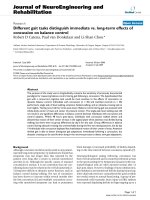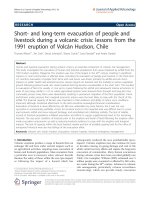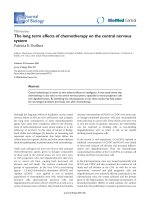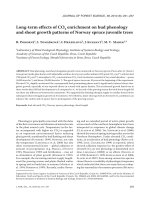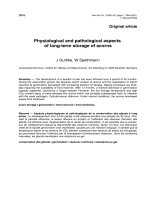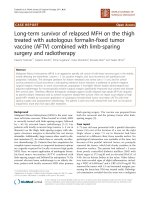Long term effect of manure and fertilizers on depthwise distribution of total Zn, Cu, Fe and Mn under rice-wheat system
Bạn đang xem bản rút gọn của tài liệu. Xem và tải ngay bản đầy đủ của tài liệu tại đây (344.7 KB, 13 trang )
Int.J.Curr.Microbiol.App.Sci (2019) 8(1): 3179-3191
International Journal of Current Microbiology and Applied Sciences
ISSN: 2319-7706 Volume 9 Number 01 (2019)
Journal homepage:
Original Research Article
/>
Long Term Effect of Manure and Fertilizers on Depthwise Distribution of
Total Zn, Cu, Fe and Mn under Rice-Wheat System
M.K. Dhaliwal1, S.S. Dhaliwal2* and A.K. Shukla3
1
Department of Soil and Water Conservation, Punjab
Punjab Agricultural University, Ludhiana– 141004
3
Indian Institute of Soil Science, Bhopal, Madhya Pradesh
2
*Corresponding author
ABSTRACT
Keywords
Total Zn, Cu, Fe
and Mn, Biogas
slurry manure,
Chemical fertilizers,
Rice-wheat system
Article Info
Accepted:
22 December 2018
Available Online:
10 January 2019
Laboratory analysis was made on the soil samples collected (October 2013) from
an on-going long-term field experiment (in progress since Kharif 2009-10) at
Department of Soil Science, PAU, Ludhiana to investigate the effect of manure
and chemical fertilizers in rice (Oryza sativa L.) - wheat (Triticum aestivum L.)
system. The organic manure through bio gas slurry (BGS) @ 6 t ha -1 was
incorporated along with nitrogen fertilizer (N @ 80 and 120 kg ha-1), phosphorus
fertilizer (P @ 30 kg ha-1) and potassium fertilizer (K @ 30 kg ha-1) to the rice
crop. The results of our study reported that the total Zn decreased with increase in
soil depth, whereas the increased concentration of total Cu, Fe and Mn was
observed at lower soil depths. Higher concentration of total Zn, Cu, Fe and Mn
was also found in the treatments where organic manure (BGS) was added @ 6 t
ha-1 along with N @ 80 kg ha-1 and K @ 30 kg ha-1 to the rice crop. The results of
this study were of practical utility since application of manure and chemical
fertilizers together increased total Zn, Cu, Fe and Mn in the surface soil whereas,
their concentrations decreased with depth.
Introduction
Rice (Oryza sativa L.) - wheat (Triticum
aestivum L.) is the predominant cropping
system, being practiced by majority of farmers
in different agro-climatic zones of Punjab.
Production of food grains is increasing year
after year due to intensive cultivation of land
thereby depleting a huge amount of
macronutrients along with micronutrients.
Relatively, over use of macronutrient
fertilizers, decreased use of organic manures,
reduced recycling of crop residues, and
bumper harvests in the past three decades have
induced
secondary
and
micronutrient
deficiencies in the Indo Gangetic Plains.
Dhaliwal and Walia (2008) reported that
incorporation of manures in the soil has
beneficial effect on soil health by improving
physico-chemical properties besides supplying
the micronutrients like Zn, Cu, Fe and Mn.
Herencia et al., (2008) reported that with the
3179
Int.J.Curr.Microbiol.App.Sci (2019) 8(1): 3179-3191
addition of organic and mineral fertilization,
OM-bound fractions of micronutrients
increased their availability and uptake in the
soil. Singhet al., (1988) reported that Fe and
Mn associated with organic matter (OMbound fraction) increased with application of
manure, which increased the yield under ricewheat system. However, Sharma et al.,(2004)
reported the decrease of total fraction with
green manure after the harvest of wheat which
could be due to an increase in the water
soluble plus exchangeable fraction as well as
held on inorganic sites. In a field experiment,
Behera et al., (2008) reported the distribution
of total micronutrient, Zn fractions and their
contribution toward availability and plant
uptake of Zn under long-term maize-wheat
cropping in an inceptisol. Dhaliwal et al.,
(2011) reported distribution of total
micronutrient fractions and their contribution
towards availability and plant uptake of
micronutrient under long term maize-wheat
cropping
sequence
indicated
residual
micronutrients as the dominant proportion of
total Zn and Cu. Zhang et al., (2008)
observed the long term effect of manure
application on micronutrients availability
under rice-wheat and maize-wheat cropping
systems. They reported that the DTPAextractable Zn and Cu availability was higher
in maize-wheat cropping system as compared
to rice-wheat cropping system. Distribution of
total Zn, Cu, Fe and Mn and their contribution
towards availability and plant uptake under
long-term maize-wheat system was reported
by Agbenin and Henningsen (2003) who
indicated that the residual micronutrient
fraction as the dominant portion of total Zn,
Cu, Fe, and Mn fraction. Similarly, Behera et
al., (2008 & 2009) reported the distribution of
total Zn fraction and their contribution toward
availability and plant uptake of Zn under longterm maize-wheat cropping in an Inceptisol.
Singh et al., (1988) reported the distribution of
total Zn, Cu, Fe and Mn and their fractions in
soils. In sequential extraction scheme which
fractionated Zn, Cu, Fe and Mn into
exchangeable, carbonates-bound, organically
bound, Mn-oxide-bound, amorphous Fe-oxide
bound, crystalline Fe-oxide bound, residual
forms. It has been further reported that about
82, 62, 52 and 53 % of the total soil Zn, Cu,
Fe, and Mn respectively, was associated with
residual fraction whereas, 17, 17, 41 and 11%
of the total Zn, Cu, Fe and Mn respectively
was associated with the crystalline Fe-oxide
bound fraction.
Green manure and soil
applied Mn to rice-wheat system increased the
DTPA-extractable, water soluble plus
exchangeable and Mn specifically adsorbed on
the inorganic sites whereas, Mn held on
organic sites and oxide bound surfaces
decreased due to their conversion to other
forms (Dhaliwal et al., 2008). The vertical
distribution of micronutrients was observed by
Verma et al., (2005a and 2005b) in different
soil profiles on different physiographic units
in central Punjab which reported higher
content of micronutrient in fine textured soils
of old flood plain and lower content in sandy
soils. They further reported that DTPA -Zn,
Cu and Fe decreased with increase in soil
depth but DTPA - Mn did not follow a definite
trend.
Various research studies revealed that
application of manure in combination with
chemical fertilizers increased the OC level and
available macro as well as micronutrients in
soil. The information on surface and depth
wise distribution of available micronutrients
with application of manure and fertilizers is
meager in rice-wheat system. Also the
information of micronutrient fractions in the
system is lacking and the effect of manure and
fertilizers on physico-chemical properties of
soil under this system needs to be investigated.
Taking these points into consideration the
research has been conducted to study the
depth wise variation of total Zn, Cu, Fe and
Mn in soils under rice-wheat system.
3180
Int.J.Curr.Microbiol.App.Sci (2019) 8(1): 3179-3191
Materials and Methods
Experimental site and treatment details
In order to achieve the objectives mentioned
earlier, laboratory studies were made on the
soil samples collected from an on-going longterm experiment on role of manure and
fertilizers in rice-wheat cropping system (in
progress since Kharif 2009-10) at Department
of Soil Science, Punjab Agricultural
University, Ludhiana. The soil of experiment
field was classified as Typic Ustochrept. The
experiment was conducted in a fixed layout
since its beginning with treatments
combinations mentioned in Table 1. Each
treatment was replicated thrice in a plot size of
11×6 m2. The experiment was laid out in a
split plot design with four main and three sub
treatments. The organic manure through bio
gas slurry (BGS) @ 6 t ha-1 was incorporated
along with nitrogen fertilizer (N @ 80 and 120
kg ha-1), phosphorus fertilizer (P @ 30 kg ha-1)
and potassium fertilizer (K @ 30 kg ha-1) were
applied to the rice crop. Whereas in wheat
crop, nitrogen fertilizer (N @ 120 kg ha-1),
different levels of phosphatic fertilizer (P @
30 and 60 kg ha-1) and potassium fertilizer (K
@ 30 kg ha-1) were applied.
Various physico-chemical properties of the
experimental soil are given in Table 2. The pH
of the soil was 6.01 and the EC was 0.17 dS
m-1. The soil organic carbon was 0.33%,
available nitrogen content was 275 kg ha-1,
available phosphorus was 23 kg ha-1 and
available potassium was observed as 184 kg
ha-1. The concentration of Zn, Cu, Fe and Mn
was noted as 1.76, 0.67, 5.87 and 4.59 mg
kg-1.
phosphorus fertilizers were applied to rice and
wheat crops. Similarly, profile samples from
six periodic depths (0-15, 15-30, 30-60, 60-90,
90-120, 120-150 cm) were collected after
harvesting of rice in the month of October,
2013. Soil samples were analyzed for DTPAextractable and total Zn, Cu, Fe and Mn.
Laboratory analysis
Total Zn, Cu, Fe and Mn
For total elemental analysis of Zn, Cu, Fe and
Mn, a 0.5 gm sample of soil was digested with
5 ml of hydrofluoric acid (HF), 1.0 ml of
perchloric acid (HClO4) and 5-6 drops of
nitric acid (HNO3) in a 30 ml capacity
platinum crucibles (Page et al., 1982). When
the soil became completely dry in the crucible
the residue in the crucible was completely
dissolved in 5ml of 6N HCl.
The contents of the crucible were transferred
to 100 ml volumetric flask with double
distilled water. The digests were analyzed for
total Zn, Cu, Fe and Mn after appropriate
dilutions. The results of the elemental analysis
were reported on an oven-dry weight basis.
Laboratory analysis
Different parameters pertaining to analysis of
soil were subjected to split plot block design
analysis of variance. Critical difference (CD)
was used to compare the treatment effects at
P<0.05. The statistical analysis was done with
the help of method described by Panse and
Sukhatme (1985).
Results and Discussion
Treatment details
The experiment consists of 12 treatments with
three replications under split plot design
(Table 1). Biogas manure was applied @ 6 t
ha-1 before transplantation of rice with
different combinations of nitrogen and
The soil samples collected after harvesting of
rice from an ongoing long term experiment
were subjected to estimation for total
micronutrients viz. Zn, Cu, Fe and Mn.
3181
Int.J.Curr.Microbiol.App.Sci (2019) 8(1): 3179-3191
Depthwise distributions of total Zn
The data presented in Table 3 showed the
distribution of total Zn in profile soil (0-150
cm) samples collected after harvesting of rice
crop. The data revealed that the higher
concentrations of total Zn were observed in
surface soil as compared to subsurface soil.
Normally the total Zn decrease with increase
in soil depth under rice-wheat cropping
system.
The content of total Zn in surface soil (0-15
cm) ranged from 46.47 to 55.70 mg kg-1 in all
the treatments. It was found significantly
higher in surface soil where organic manure
has been added along with the chemical
fertilizers whereas in subsurface layers at 1530, 30-60, 60-90, 90-120 and 120-150 cm soil
depths, the concentrations of total Zn
decreased, ranged from 27.87 to 36.30, 20.60
to 29.37, 20.10 to 26.97, 21.07 to 28.27 and
22.17 to 29.47 mg kg-1 which may be due to
higher organic matter present in surface soil as
compare to subsurface soil.
The concentration decreases upto 90-120 cm
soil depth and then it increased at 120-150 cm
soil depth. Significantly higher concentration
of total Zn was observed in the treatments
where organic manure @ 6 t ha-1 has been
incorporated along with N @ 80 kg ha-1 and
P2O5 @ 30 kg ha-1 applied to the rice crop as
compared to the treatments where only N @
120 kg ha-1 was applied without application of
organic manure and P2O5 to the rice crop.
Similarly, significant increased concentration
of total Zn was also noticed in the treatments
where organic manure @ 6 t ha-1 was
incorporated along with N @ 80 kg ha-1
without the application of phosphatic fertilizer
as compared to the treatments N @ 120 kg
ha-1 and P2O5 @ 30 kg ha-1 were applied to the
rice crop without addition of organic manure.
The significant increase in the concentration
of total Zn in the treatments where organic
manure @ 6 t ha-1 was added along with N @
80 kg ha-1 and P2O5 @ 30 kg ha-1 applied to
the rice crop as compared to the treatments
where no organic manure was incorporated,
only N @ 120 kg ha-1 and P2O5 @ 30 kg ha-1
were applied. Whereas in the wheat crop, the
different levels of P2O5 (0, 30 and 60 kg ha-1)
were
applied,
significant
results
in
concentration of total Zn has been observed
with increase in levels of phosphatic fertilizer.
The interaction between rice and wheat crop is
observed as non significant.
Depth wise distribution of total Cu
Higher concentration of total Cu was
observed in the surface soil samples under
the rice-wheat cropping system as compared
to the subsurface soil samples (Table 4). The
concentration of total Cu ranged from 7.20
to 9.43 mg kg-1 in surface soil (0-15 cm).
The total Cu increased with increased in soil
depth but its concentration start decreasing
with increase in depth. The concentration for
total Cu ranged from 7.68 to 10.32, 8.43 to
9.87, 8.97 to 9.93, 8.77 to 9.87 and 8.73 to
9.93 mg kg-1 in 15-30, 30-60, 60-90, 90-120
and 120-150 cm soil depth, respectively.
Among the different treatments, a significant
increase in total Cu was noticed in the
treatments where organic manure @ 6 t ha -1
has been incorporated along with N @ 80 kg
ha-1 and P2O5 @ 30 kg ha-1 to the rice crop
as compared to the treatments where only N
@ 120 kg ha-1 was applied without P 2O5 and
organic manure application to the rice crop.
Significantly higher concentration of total
Cu was also noticed in the treatments where
organic manure @ 6 t ha -1 was applied along
with N @ 80 kg ha -1 without the application
of phosphatic fertilizer as compared to the
treatments where N @ 120 kg ha -1 and P2O5
@ 30 kg ha-1 were applied without organic
manure addition to the rice crop. In the
wheat crop, where the different levels of
P2O5 (0, 30 and 60 kg ha -1) were applied, a
3182
Int.J.Curr.Microbiol.App.Sci (2019) 8(1): 3179-3191
significant response has been observed in
concentration of total Cu at these levels of
phosphatic fertilizer.
The interaction
between rice and wheat treatments was also
observed as significant. This increase in
availability of total Cu in the plots which
were treated organically along with chemical
fertilizers may be due to reduction in the
redox - potential of the soil with the addition
of organic manures which lead to more
release of micronutrients in an available
form in the soil as compared to the
application of chemical fertilizer alone. It
was observed that total Cu remained
insignificant at lower soil depths and the
interaction between the two treatments also
found to be non significant.
Depthwise distribution of total Fe
The data presented in Table 5 showed the
distribution of total Fe in soil profile (0-150
cm) samples collected after harvesting of
rice. The results revealed that concentrations
of total Fe ranged from 1.25 to 1.51 per cent
in surface soil (0-15 cm) and these
concentrations further increased with increase
in soil depths. It was observed that the total
Fe concentration varied from 1.40 to 1.55,
1.45 to 1.65, 1.57 to 1.73, 1.56 to 1.74 and
1.64 to 1.81 % in 15-30, 30-60, 60-90, 90120 and 120-150 cm soil depth, respectively.
Significantly higher level of total Fe was
reported in the treatments where organic
manure @ 6 t ha-1 has been incorporated along
with N @ 80 kg ha-1 and P2O5 @ 30 kg ha-1 to
the rice crop as compared to the treatments
where N @ 120 kg ha-1 was applied without
organic manure and P2O5 application to the
rice crop. Significantly higher concentration of
total Fe was also noticed in the treatments
where organic manure @ 6 t ha-1 was added
along with N @ 80 kg ha-1 without the
application of phosphatic fertilizer as
compared to the treatments where N @ 120 kg
ha-1 and P2O5 @ 30 kg ha-1 were applied to the
rice crop without addition of organic manure.
On the other hand in the wheat crop, where the
different levels of P2O5 (0, 30 and 60 kg ha-1)
were applied, a significant response has been
observed in concentration of total Fe at these
levels of phosphatic fertilizer. Higher content
of total Fe was observed which may be due to
the effect of submergence and may be further
associated with more organic matter present in
surface soil. Similar results were observed by
Khan et al., (2002), who reported the higher
concentration of total Fe in surface (0-15 cm)
as compared to the subsurface layers under
rice-wheat system. Similarly, Elbordiny and
Camilia (2008) reported that the significantly
positive correlation of total Fe with organic
matter content in surface and subsurface soil.
The interaction between rice and wheat crop
treatments is also observed as significant.
Depthwise distributions of total Mn
The total Mn concentration in surface soil (015 cm) ranged from 203.6 to 219.8 mg kg -1
under rice-wheat cropping system (Table 6).
The total Mn increased with increase in soil
depth. It varied from 285.5 to 305.3, 297.2 to
326.4, 316.5 to 345.3, 332.7 to 360.9 and
363.6 to 386.5 mg kg-1 at 15-30, 30-60, 6090, 90-120 and 120-150 cm soil depths,
respectively. The level of total Mn at lower
depths was higher may be due to
submergence and it leached down to lower
layers. The data reported the significant
increase in the concentration of total Mn in
the treatments where organic manure @ 6 t
ha-1 has been added along with N @ 80 kg ha 1
and P2O5 @ 30 kg ha-1 which were applied
to the rice crop as compared to the treatments
where only N @ 120 kg ha -1 was applied
without organic manure and P fertilizer
application.
Significantly higher concentration of total
Mn was also noticed in the treatments where
3183
Int.J.Curr.Microbiol.App.Sci (2019) 8(1): 3179-3191
organic manure @ 6 t ha-1 was incorporated
along with N @ 80 kg ha-1 without the
application of phosphatic fertilizer as
compared to the treatments where no organic
manure was added but N @ 120 kg ha -1 and
P2O5 @ 30 kg ha-1 were applied to the rice
crop. Also, the significantly higher
concentration was observed in the treatments
where organic manure @ 6 t ha -1 was added
along with N @ 80 kg ha-1 and P2O5 @ 30 kg
ha-1 applied to the rice crop as compared to
the treatments where no organic manure was
incorporated but N @ 120 kg ha-1 and P2O5
@ 30 kg ha-1 were applied to the rice crop.
Whereas in the wheat crop, the different
levels of P2O5 (0, 30 and 60 kg ha-1) were
applied, a significant response was observed
in concentration of total Mn at these levels.
Table.1 Treatment details of long-term experiment on rice-wheat cropping system
Treatments
T1
T2
T3
T4
T5
T6
T7
T8
T9
T10
T11
T12
Manure
(t ha-1)
0
0
0
6
6
6
0
0
0
6
6
6
Rice
N
P2O5
(kg ha-1)
120
120
120
80
80
80
120
120
120
80
80
80
0
0
0
30
30
30
30
30
30
0
0
0
Wheat
P2O5
(kg ha-1)
0
30
60
0
30
60
0
30
60
0
30
60
Table.2 Physico-chemical properties of experimental soil before sowing of wheat
Parameter
Texture
pH (1:2 )
EC (dSm-1)
Organic carbon (%)
Available nitrogen (kg ha-1)
Available phosphorus (kg ha-1)
Available potassium (kg ha-1)
Total zinc (mg kg-1)
Total copper (mg kg-1)
Total iron (%)
Total manganese (mg kg-1)
3184
Value
Loamy sand
6.71
0.17
0.33
275
23
184
26.46
6.62
1.14
186.4
Int.J.Curr.Microbiol.App.Sci (2019) 8(1): 3179-3191
Table.3 Depth wise distribution of total Zn (mg kg-1) under rice-wheat system
Treatments of
rice
M0 N120 P0
M6 N80 P30
M0 N120 P30
M6 N80 P0
Mean
LSD (p<0.05)
M0 N120 P0
M6 N80 P30
M0 N120 P30
M6 N80 P0
Mean
LSD (p<0.05)
M0 N120 P0
M6 N80 P30
M0 N120 P30
M6 N80 P0
Mean
LSD (p<0.05)
Rates of P applied to wheat (kg P2O5 ha-1)
P0
P30
P60
0-15 cm
51.37
50.60
50.93
53.03
53.40
50.67
49.13
47.87
46.47
55.70
54.92
54.20
52.31
51.70
50.57
R=1.39, W=0.96, RxW=NS
15-30 cm
30.00
28.50
28.20
32.03
30.50
30.27
28.77
27.87
34.07
36.30
33.70
33.40
31.78
30.14
31.48
R=2.04, W=NS, RxW=3.60
30-60 cm
26.67
26.47
24.50
27.07
26.63
26.85
24.63
21.90
20.60
29.37
26.70
26.60
26.93
25.43
24.64
R=1.30, W=0.83, RxW=1.65
Mean
50.97
52.37
47.82
54.94
51.52
28.90
30.93
30.23
34.47
31.13
25.88
26.85
22.38
27.56
25.66
3185
Rates of P applied to wheat (kg P2O5 ha-1)
P0
P30
P60
60-90 cm
23.40
22.10
21.20
24.33
23.60
23.67
23.83
23.00
20.10
26.97
25.67
25.17
24.63
23.59
22.53
R=1.62, W=0.89, RxW=NS
90-120 cm
21.10
22.67
22.17
25.47
25.47
23.47
22.13
22.33
21.07
27.27
24.90
28.27
23.99
23.84
23.74
R=1.30, W=NS, RxW=NS
120-150 cm
24.43
22.60
24.43
25.00
24.83
24.33
22.73
22.17
30.87
29.47
28.93
25.40
25.41
24.63
26.26
R=2.33, W=NS, RxW=3.13
Mean
22.23
23.87
22.31
25.93
23.58
21.98
24.80
21.84
26.81
23.85
23.82
24.72
25.26
27.93
25.43
Int.J.Curr.Microbiol.App.Sci (2019) 8(1): 3179-3191
Table.4 Depth wise distribution of total Cu (mg kg-1) under rice-wheat system
Treatments of
rice
M0 N120 P0
M6 N80 P30
M0 N120 P30
M6 N80 P0
Mean
LSD (p<0.05)
M0 N120 P0
M6 N80 P30
M0 N120 P30
M6 N80 P0
Mean
LSD (p<0.05)
M0 N120 P0
M6 N80 P30
M0 N120 P30
M6 N80 P0
Mean
LSD (p<0.05)
Rates of P applied to wheat (kg P2O5 ha-1)
P0
P30
P60
0-15 cm
7.70
7.64
7.43
8.29
8.27
7.88
7.63
7.44
7.20
9.43
9.23
8.23
8.26
8.14
7.69
R=0.17, W=0.15, RxW=0.29
15-30 cm
8.87
8.77
8.67
10.32
9.77
9.47
8.10
7.68
7.87
9.67
9.74
9.77
9.24
8.99
8.94
R=0.27, W=NS, RxW=NS
30-60 cm
8.43
9.57
9.23
9.53
9.30
9.37
9.23
8.57
8.80
9.87
9.77
9.50
9.27
9.30
9.22
R=0.55, W=NS, RxW=NS
Mean
7.59
8.14
7.42
8.97
8.03
8.77
9.85
7.88
9.72
9.05
9.08
9.40
8.87
9.71
9.26
3186
Rates of P applied to wheat (kg P2O5 ha-1)
P0
P30
P60
60-90 cm
9.60
9.48
9.57
9.73
9.73
9.39
8.97
9.23
9.01
9.93
9.40
9.33
9.56
9.46
9.32
R=0.36, W=NS, RxW=NS
90-120 cm
9.47
9.33
8.97
9.57
9.87
9.17
9.20
8.77
9.30
9.60
9.36
9.30
9.46
9.33
9.18
R=NS, W=NS, RxW=NS
120-150 cm
9.33
8.97
9.63
9.73
9.40
9.10
8.73
8.98
9.90
9.63
9.67
9.93
9.36
9.25
9.64
R=NS, W=NS, RxW=NS
Mean
9.55
9.62
9.07
9.56
9.44
9.25
9.54
9.09
9.42
9.32
9.31
9.41
9.20
9.74
9.41
Int.J.Curr.Microbiol.App.Sci (2019) 8(1): 3179-3191
Table.5 Depth wise distribution of total Fe (%) under rice-wheat system
Treatments of
rice
M0 N120 P0
Rates of P applied to wheat (kg P2O5
ha-1)
P0
P30
P60
0-15 cm
1.43
1.38
1.37
Mean
Rates of P applied to wheat (kg P2O5 ha-1)
P0
P30
Mean
P60
60-90 cm
1.39
1.60
1.63
1.63
1.62
M6 N80 P30
1.47
1.45
1.43
1.45
1.64
1.64
1.67
1.65
M0 N120 P30
1.33
1.37
1.25
1.31
1.57
1.59
1.62
1.59
M6 N80 P0
1.51
1.49
1.48
1.49
1.67
1.69
1.73
1.70
Mean
1.43
1.42
1.38
1.41
1.62
1.64
1.66
1.64
LSD (p<0.05)
R=NS, W=NS, RxW=NS
15-30 cm
1.45
1.44
M0 N120 P0
1.44
M6 N80 P30
1.45
1.46
M0 N120 P30
1.40
M6 N80 P0
Mean
R=0.02, W=0.01, RxW=NS
90-120 cm
1.61
1.63
1.44
1.60
1.49
1.47
1.66
1.65
1.67
1.66
1.41
1.43
1.42
1.56
1.58
1.60
1.58
1.50
1.53
1.55
1.53
1.69
1.72
1.74
1.71
1.45
1.46
1.48
1.46
1.63
1.64
1.66
1.64
LSD (p<0.05)
R=0.02, W=0.02, RxW=NS
1.62
R=0.01, W=0.01, RxW=NS
M0 N120 P0
1.54
30-60 cm
1.54
M6 N80 P30
1.57
1.58
1.62
1.59
1.74
1.74
1.76
1.75
M0 N120 P30
1.45
1.48
1.52
1.48
1.64
1.66
1.67
1.66
M6 N80 P0
1.63
1.63
1.65
1.64
1.78
1.79
1.81
1.79
Mean
1.55
1.56
1.59
1.56
1.72
1.72
1.74
1.72
LSD (p<0.05)
1.56
1.55
R=0.02, W=0.01, RxW=NS
1.70
120-150 cm
1.70
1.73
1.71
R=0.02, W=0.01, RxW=NS
3187
Int.J.Curr.Microbiol.App.Sci (2019) 8(1): 3179-3191
Table.6 Depth wise distribution of total Mn (mg kg-1) under rice-wheat system
Treatments of
rice
M0 N120 P0
M6 N80 P30
M0 N120 P30
M6 N80 P0
Mean
LSD (p<0.05)
M0 N120 P0
M6 N80 P30
M0 N120 P30
M6 N80 P0
Mean
LSD (p<0.05)
M0 N120 P0
M6 N80 P30
M0 N120 P30
M6 N80 P0
Mean
LSD (p<0.05)
Rates of P applied to wheat (kg P2O5 ha-1)
P0
P30
P60
0-15 cm
216.3
215.7
213.7
217.2
215.7
217.1
210.1
205.3
203.6
219.8
218.8
218.7
215.8
213.9
213.3
R=0.95, W=0.92, RxW=1.84
15-30 cm
290.4
293.2
295.5
297.4
299.6
303.3
285.5
289.2
288.0
305.3
303.7
302.3
294.7
296.4
297.3
R=1.04, W=0.97, RxW=1.95
30-60 cm
310.8
306.9
305.5
317.1
316.5
313.7
304.8
299.1
297.2
326.4
324.3
321.3
314.8
311.7
309.3
R=1.50, W=1.59, RxW=NS
Mean
215.2
216.7
206.4
219.1
214.3
293.0
300.1
287.6
303.8
296.1
307.7
315.8
300.4
323.9
311.9
3188
Rates of P applied to wheat (kg P2O5 ha-1)
P0
P30
P60
60-90 cm
332.5
331.5
327.7
337.0
335.8
334.3
321.2
317.0
316.5
345.3
343.3
340.4
334.0
331.9
329.7
R=1.30, W=1.03, RxW=NS
90-120 cm
349.1
346.5
342.8
352.7
350.8
349.6
340.3
338.3
332.7
360.9
358.3
354.8
350.8
348.5
344.9
R=1.41, W=1.01, RxW=NS
120-150 cm
373.9
370.7
371.8
382.3
379.9
376.5
367.5
364.5
363.6
386.5
384.5
384.6
377.6
374.9
374.1
R=1.93, W=1.08, RxW=NS
Mean
330.6
335.7
318.2
343.0
331.8
346.1
351.0
337.1
358.0
348.1
372.1
379.6
365.2
385.2
375.5
Int.J.Curr.Microbiol.App.Sci (2019) 8(1): 3179-3191
The interaction between rice and wheat
treatments is observed as significant. Similar
results were observed by Sharma et al.,
(2000) and Lu et al., (2004), who reported
that the continuous use of rice-wheat
cropping system year after year reduced the
Mn due to leaching down to lower depth of
soil.
Vitamin C content in different hoblies of
different district of Karnataka is tabulated in
table 2. Vitamin C content was significantly
high in almost all the hoblies of Shimoga
district. Banagi and Muturu hobli were having
(1056.82 and 1056.81ppm) of vitamin C
content and followed by kasaba hobli of
Hosanagara taluk (1056.77ppm), Talaguppa
hobli (1056.66ppm) and kasaba hobli of
Bhadravathi taluk (1056.55ppm). Less
concentration was identified in kasaba hobli
of Shimoga taluk 352.11ppm, nidige hobli
352.33ppm respectively.
In Chikkamagalur district, more vitamin c
content was found in Kasaba hobli of Sringeri
taluk (1056.84ppm), Kalasa and Kasaba hobli
of Mudigere taluk had 1056.53 and
1056.51ppm of vitamin C content and less
concentration was estimated in Lakya and
khandya hobli of Chikkamagalur taluk
(528.22 and 528.68ppm), and Kasaba hobli of
Narasimharajapura taluk (528.67ppm).
There was no significant difference of vitamin
C content in Davangere district. The vitamin c
ion
concentration
was
similar
in
Santhebennuru
and
Anagodu
hobli
(1056.33ppm). In Kasaba hobli of Honnali
taluk and in Belaguthi hobli vitamin C content
was found to be (1056.50 and 1056.74ppm).
In Chitradurga district there was a significant
variation of vitamin C content. The highest
concentration of vitamin C was found in
Kasaba hobli of Holalkere taluk (792.63ppm)
and less content was observed in Ramagiri
hobli (264.56ppm) and followed by Imangala
hobli, Hireguntanuru hobli (264.75ppm and
264.79ppm).
In Kadaba hobli of Dakshina kannada district
were having more concentration of vitamin C
content (792.79ppm), and followed by
Bantwala and vitla hobli (792.52 and
792.50ppm) and Mangaluru B and Mudabidre
were having less content of vitamin C (264.75
and 264.56ppm). In Udupi district high
concentration of vitamin C was identified in
Kota hobli (792.22ppm) and less content was
found in Vandse hobli 264.37ppm and
followed by Ajekaru and Karkalla hobli of
karakala taluk (264.55ppm and 264.56ppm).
Vitamin B6, also called pyridoxine, is a watersoluble nutrient that is part of the B vitamin
family. B vitamins, including vitamin B6,
help support adrenal function, help calm and
maintain a healthy nervous system, and are
necessary for key metabolic processes.
Vitamin B6 acts as a coenzyme in the
breakdown and utilisation of carbohydrates,
fats and proteins. Vitamin B6 helps in the
production
of
neurotransmitters,
the
chemicals that allow brain and nerve cells to
communicate with one another, ensuring that
metabolic processes such as fat and protein
metabolism run smoothly, and is important
for the functioning of immune system in older
individuals.
The result of samples analysed for vitamin B6
from 117 locations of six important areca
growing districts of Karnataka are presented
in the table 1. In general, the contents of
vitamin B6 ranged from 10 to 91 ppm. Higher
vitamin B6 contents were in Anwatti (52.33),
Kigga
(72.67),
Bilichodu
(84.67),
Turuvanooru (72.67), Uppinangadi (91.22)
and
Ajekaru
(81.00)
of
Shimoga,
Chikkamagaluru, Davanagere, Chitradurga,
Dakshina kannada and Udupi districts
3189
Int.J.Curr.Microbiol.App.Sci (2019) 8(1): 3179-3191
respectively. It is interesting to notice that, in
about 30 percent of locations the content of
vitamin B6 was only 10 ppm. Talukwise
variation was highly significant with a range
of 10.24 to 88.38 ppm. Highest vitamin B6
was observed in samples of Puttur (88.38)
followed by Karkala (67.98) and Hosadurga
(56.44) whereas lowest concentration was in
Hosanagara (10.21). The mean vitamin
content was lowest in Shimoga district
(15.68) and highest was in Dakshina Kannada
district (50.49).
Regarding vitamin C contents, there were a
significant differences among the hoblies of
all the six districts of Karnataka. Vitamin
content in different hoblies has been
presented in table 3. The samples of 8 hoblies
viz. Alduru, Panchanahalli, Gonibidu,
Balehonnuru, Basavapatna, Kasaba, Arsikere
and Govinkovi contained highest vitamin C
content of 1320 ppm but lower content was
found in 10 hoblies viz. Hiregunturu,
Imangala, Kasaba, Ramagiri, Mangaluru,
Mudabidre, Ajekaru, Karkala, Kundapura and
Vadse wherein its concentration was only 264
ppm. Highly significant variations existed in
vitamin C content among all the 35 taluks of 6
districts (Table 4). Mean over all the taluks
indicated that highest vitamin C content (1012
ppm) was in Davanagere district followed by
Shimoga and Chikamagaluru districts (897
ppm). Similarly, Areca nut Research and
Development Foundation (ARDF 2015), Sirsi
have reported that, vitamin-A and vitamin B-6
were found in traces in areca nut samples of
Karnataka.
The determination of vitamin B6, it should be
noted that vitamin B6 are usually unstable and
therefore the reference and sample protocols
must be handled with great care while using
HPLC. Separation and quantification should
be done with a high level of precision and
suitable methods. HPLC method for analysing
vitamin B6 is common but a single run HPLC
method for simultaneous analysis of vitamins
are undocumented. It is therefore important to
have a single most sensitive HPLC method,
which is robust, rapid and efficient for
determining all the water-soluble vitamins in
a single run. Both hobli wise and taluk wise
areca samples recorded highly significant
variations in vitamin B6 contents with a range
of 91.33 to 10.00 ppm.
References
Agbenin, J. O. and Henningsen. 2003. The
distribution and transformation of iron
and manganese in soil fraction in a
savanna alfisol under continuous
cultivation.
NutrCyclAgroecosys66:
259-270.
Behera, S. K., Singh, D., Dwivedi, B. S.,
Singh, S., Kumar, K. and Rana, D. S.
2008. Distribution of fraction of zinc
and
their
contribution
towards
availability and plant uptake of zinc
under long-term maize (Zea mays L.) wheat (Triticum aestivum L.) cropping
on an Inceptisol. Aust J Soil Res 46: 8389.
Behera, S. K., Singh, D. and Dwivedi, B. S.
2009.Changes in fractions of iron,
manganese, copper and zinc in soil
under continuous cropping for more
than three decades. Commun Soil Sci
Plant Anal 40: 1380-1407.
Dhaliwal, S. S.2008. Different chemical pools
of Mn as influenced by submergence,
green manure and soil applied Mn under
rice- wheat system. Asian J Soil Sci
3(1): 94-98.
Dhaliwal, S. S. and Walia, S. S. 2008.
Integrated nutrient management for
sustaining maximum productivity of
rice-wheat system under Punjab
conditions. J Res PAU 45:12-16.
Dhaliwal, S. S, Sadana, U. S., Sidhu, S. S. and
Gurpreet, S. 2011. Role of cropping
systems in amelioration of aggravated
3190
Int.J.Curr.Microbiol.App.Sci (2019) 8(1): 3179-3191
micronutrients deficiency in alluvial
soils of Punjab. J Pl Sci Res27: 21-29.
Elbordiny, M. M. and Camilia, Y. D. 2008.
Effect of some salt affected soil
properties on micronutrients availability.
J Appl Sci Res 4(11): 1569-1573.
Herencia, J. F., Ruiz, J. C., Melero, M. S.,
Villaverde, J. and Maqueda, C. 2008.
Effects of organic and mineral
fertilization
on
micronutrient
availability in soil. Soil Sci173: 69-80.
Khan, M. S. H., Mian, M. J., Akhtar, A.,
Hossain, M. F. and Sikder, M. S. I.
2002.Effects of long term fertilization
and cropping on micronutrient cations
of soils in Bangladesh. Pak J Biol Sci
5:543-544.
Lu, S., Liu, X., Li,L., Zhang, F., Zhang, X.
and Tang, C. 2004.Effect of manganese
spatial distribution in the soil profile on
wheat growth in rice-wheat rotation.Pl
Soil 261: 39-46.
Page, A. L., Miller, R. H. and Keeney, D. R.
1982. Methods of soil analysis. Part 2,
2nd edition. Am Soc Agron, Madison,
Wisconsin, USA.
Panse, V. G.and
Sukhatme, P. V.
1985.Statistical methods for agricultural
workers 4thEdn. ICAR, New Delhi, pp
359.
Sharma, B. D., Harsh, A., Kumar, R. and
Nayyar, V. K. 2004.Relationships
between soil characteristics and total
and DTPA-extractable micronutrients in
Inceptisols of Punjab. Commun Soil Sci
Pl Anal 37: 799-818.
Sharma, M. P., Bali, S. V. and Gupta, D. K.
2000.Crop yield and properties of
inceptisol as influenced by residue
management under rice-wheat cropping
sequence. J Indian Soc Soil Sci 48: 506509.
Singh, J. P., Karwasra, S. P. S. and Singh, M.
1988.Distribution and forms of copper,
iron, manganese and zinc in calcareous
soils of India. J Indian Soc Soil Sci146:
359-66.
Verma, A., Nepalia, V. and Kanthaliya, P. C.
2005a.Effect of decade long – term
fertilizer and manure application on soil
fertility and productivity of rice-wheat
system in a Mollisol. J Indian Soc Soil
Sci 53: 365-368.
Verma, V. K., Setia, R. K., Sharma, P. K.,
Singh,
C.
and
Kumar,
A.
2005b.Pedospheric
Variations
in
distribution of DTPA- extractable
micronutrients in soils developed on
different physiographic units in central
parts of Punjab, India. Int J Agri Biol
7(2): 243-246.
Zhang, L., He, M., Zhang, X. E. and Stoffela,
P. J. 2008.Long term effect of manure
application on micronutrient availability
under rice-wheat and maize-wheat
cropping systems. Soil Sci Soc Am J 70:
1699-1717.
How to cite this article:
Dhaliwal, M.K., S.S. Dhaliwa and Shukla, A.K. 2019. Long Term Effect of Manure and
Fertilizers on Depthwise Distribution of Total Zn, Cu, Fe and Mn under Rice-Wheat System.
Int.J.Curr.Microbiol.App.Sci. 8(01): 3179-3191. doi: />
3191


